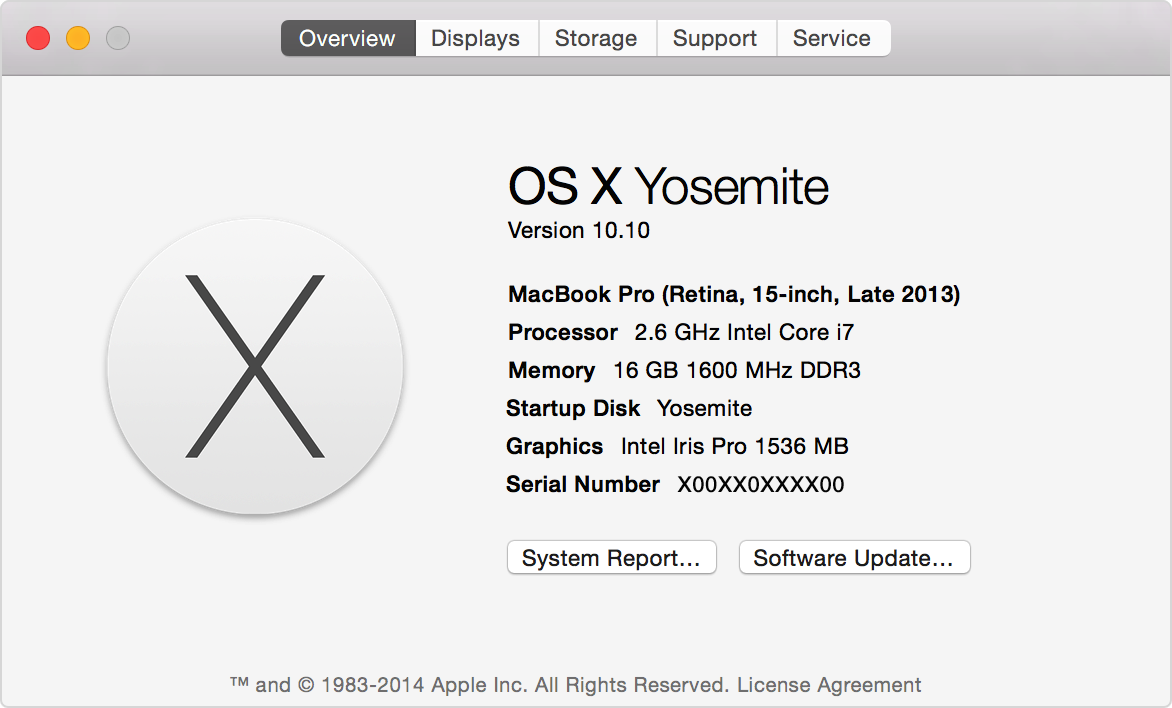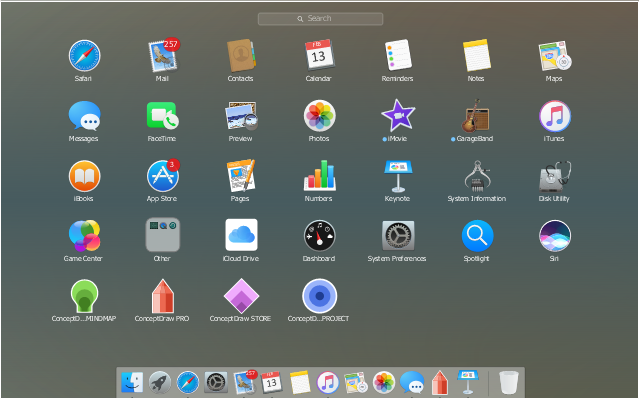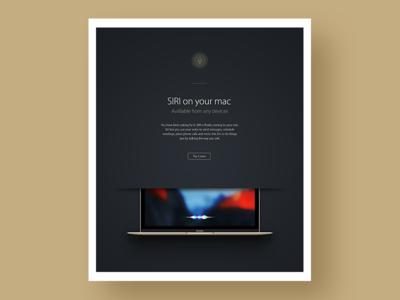Free siri download for mac. System Tools downloads - Siri by Diabolisch Dev Team and many more programs are available for instant and free download. However, Apple plans to launch OS X 10.10 Yosemite later this year, and while Siri support hasn't been announced so far, that could change. CNET has contacted Apple.
- Mac Yosemite Update
- Mac Yosemite Download
- Yosemite Siri For Macbook
- Yosemite Siri For Mac Os
- Yosemite Siri For Mac Desktop
- Siri Yosemite Macbook
When you upgrade to macOS Catalina, you get more of everything you love about Mac. Experience dedicated apps for music, TV, and podcasts. Smart new features in the apps you use every day. And Sidecar, which lets you use iPad as a second Mac display. Best of all, upgrading is free and easy.
Chances are, your Mac can run macOS Catalina.
Mac computers with Metal-capable graphics processors (GPUs) can upgrade to macOS Catalina.
Make sure you’re ready to upgrade.
Before you upgrade, we recommend that you back up your Mac. Then, if your Mac is running OS X Mavericks 10.9 or later, you can upgrade directly to macOS Catalina.
Upgrading is free. And easier than you think.
Upgrading from macOS Mojave?
Go to Software Update in System Preferences to find the macOS Catalina upgrade. Click Upgrade Now and follow the onscreen instructions to begin your upgrade. If you don’t have broadband access, you can upgrade your Mac at any Apple Store.
Upgrading from an older version of macOS?
If you’re running High Sierra (10.13), Sierra (10.12), or El Capitan (10.11), upgrade to macOS Catalina from the App Store. If you’re running Lion (10.7) or Mountain Lion (10.8), you will need to upgrade to El Capitan (10.11) first. If you don’t have broadband access, you can upgrade your Mac at any Apple Store.
- OS X 10.9 or later
- 4GB of memory
- 12.5GB of available storage (OS X El Capitan 10.11.5 or later)*
- Some features require an Apple ID; terms apply.
- Some features require a compatible internet service provider; fees may apply.
For details about your Mac model, click the Apple icon at the top left of your screen and choose About This Mac. These Mac models are compatible with macOS Catalina:
- MacBook (Early 2015 or newer)
- MacBook Air (Mid 2012 or newer)
- MacBook Pro (Mid 2012 or newer)
- Mac mini (Late 2012 or newer)
- iMac (Late 2012 or newer)
- iMac Pro (2017)
- Mac Pro (Late 2013 or newer)
Siri
Requires a broadband internet connection and microphone (built-in or external).
Hey Siri
Supported by the following Mac models:
- MacBook Pro (2018 or newer)
- MacBook Air (2018 or newer)
- iMac Pro
Dictation, Voice Control, and Voice Memos
Requires a microphone (built-in or external).
Spotlight Suggestions
Requires a broadband internet connection.
Gestures
Requires a Multi-Touch trackpad, Force Touch trackpad, Magic Trackpad, or Magic Mouse.
Force Touch gestures require a Force Touch trackpad.
VoiceOver gestures require a Multi-Touch trackpad, Force Touch trackpad, or Magic Trackpad.
Photo Booth
Requires a FaceTime or iSight camera (built-in or external), or USB video class (UVC) camera.
FaceTime
Audio calls require a microphone (built-in or external) and broadband internet connection.
Video calls require a built-in FaceTime camera, an iSight camera (built-in or external), or a USB video class (UVC) camera; and broadband internet connection.
Apple TV
High Dynamic Range (HDR) video playback is supported by the following Mac models:
- MacBook Pro (2018 or newer)
- iMac Pro (2017)
- Mac Pro (2019) with Pro Display XDR
Dolby Atmos soundtrack playback is supported by the following Mac models:
- MacBook Air (2018 or newer)
- MacBook Pro (2018 or newer)
Sidecar
Supported by the following Mac models:
- MacBook (2016 or newer)
- MacBook Air (2018 or newer)
- MacBook Pro (2016 or newer)
- Mac mini (2018 or newer)
- iMac (late 2015 or newer)
- iMac Pro (2017 or newer)
- Mac Pro (2019)
Supported by all iPad models with Apple Pencil support:
- 12.9-inch iPad Pro
- 11-inch iPad Pro
- 10.5-inch iPad Pro
- 9.7-inch iPad Pro
- iPad (6th generation or later)
- iPad mini (5th generation)
- iPad Air (3rd generation)
Continuity Camera
Requires an iPhone or iPad with a Lightning connector and iOS 12 or later.
Continuity Sketch and Continuity Markup
Requires an iPhone with iOS 13 or an iPad with iPadOS.
Handoff
Requires an iPhone or iPad with a Lightning connector and iOS 8 or later.
Instant Hotspot
Requires an iPhone or iPad with cellular connectivity, a Lightning connector, and iOS 8.1 or later. Requires Personal Hotspot service through your carrier.
Universal Clipboard
Requires an iPhone or iPad with a Lightning connector and iOS 10 or later.
Auto Unlock
Supported by Mac models introduced in mid 2013 or later.
Requires an Apple Watch with watchOS 3 or later or an iPhone 5 or later.
Approve with Apple Watch
Supported by Mac models introduced in mid 2013 or later.

Requires an Apple Watch with watchOS 6 or later or an iPhone 6s or later with iOS 13.
Apple Pay on the Web

Requires MacBook Pro with Touch Bar, an iPhone 6 or later with iOS 10 or later, or an Apple Watch with watchOS 3 or later.
Phone Calling
Requires an iPhone with iOS 8 or later and an activated carrier plan.
SMS
Requires an iPhone with iOS 8.1 or later and an activated carrier plan.
Home
Requires an iPhone with iOS 12 or later and a configured Home app.
AirDrop
AirDrop to iOS and iPadOS devices requires an iPhone or iPad with a Lightning connector and iOS 7 or later.
AirPlay
AirPlay Mirroring requires an Apple TV (2nd generation or later).

AirPlay for web video requires an Apple TV (2nd generation or later).
Peer-to-peer AirPlay requires a Mac (2012 or later) and an Apple TV (3rd generation rev A, model A1469 or later) with Apple TV software 7.0 or later.
Time Machine
Requires an external storage device (sold separately).
Power Nap
Supported by the following Mac models:
- MacBook (Early 2015 or newer)
- MacBook Air (Mid 2012 or newer)
- MacBook Pro with Retina display (Mid 2012 or newer)
- Mac mini (Late 2012 or newer)
- iMac (Late 2012 or newer)
- iMac Pro (2017)
- Mac Pro (Late 2013 or newer)
Boot Camp
Allows Boot Camp installations of Windows 10 on supported Mac models.
Exchange Support
Requires Microsoft Office 365, Exchange 2016, Exchange 2013, or Exchange Server 2010. Installing the latest Service Packs is recommended.
Windows Migration
Supports OS X 10.7 or later and Windows 7 or later.
Mac Yosemite Update
App Store
Available only to persons age 13 or older in the U.S. and many other countries and regions.
- Apple Books
- Apple News
- App Store
- Automator
- Calculator
- Calendar
- Chess
- Contacts
- Dictionary
- DVD Player
- FaceTime
- Find My
- Font Book
- Home
- Image Capture
- Launchpad
- Maps
- Messages
- Mission Control
- Music
- Notes
- Photo Booth
- Photos
- Podcasts
- Preview
- QuickTime Player
- Reminders
- Safari
- Siri
- Stickies
- Stocks
- System Preferences
- TextEdit
- Time Machine
- TV
- Voice Memos
- Activity Monitor
- AirPort Utility
- Audio MIDI Setup
- Bluetooth File Exchange
- Boot Camp Assistant
- ColorSync Utility
- Console
- Digital Color Meter
- Disk Utility
- Grapher
- Keychain Access
- Migration Assistant
- Screenshot
- Screen Time
- Script Editor
- Sidecar
- System Information
- Terminal
- VoiceOver Utility
- Arabic
- Catalan
- Croatian
- Simplified Chinese
- Traditional Chinese
- Traditional Chinese (Hong Kong)
- Czech
- Danish
- Dutch
- English (Australia)
- English (UK)
- English (U.S.)
- Finnish
- French
- French (Canada)
- German
- Greek
- Hebrew
- Hindi
- Hungarian
- Indonesian
- Italian
- Japanese
- Korean
- Malay
- Norwegian
- Polish
- Brazilian Portuguese
- Portuguese
- Romanian
- Russian
- Slovak
- Spanish
- Spanish (Latin America)
- Swedish
- Thai
- Turkish
- Ukrainian
- Vietnamese
Renaming Mac OS X as macOS brought more than new branding to Apple’s desktop initiatives. The first macOS version, “Sierra,” delivers the Siri voice-activated digital assistant, long a staple of iOS, to the Mac for the first time. In addition, some clever uses of iCloud may surprise you.
Sierra is an iterative take on the pivot Apple made with OS X Yosemite. When Yosemite was released, it brought a visual refresh along with new features. (In many ways, Yosemite is the Mac version of iOS 7, which introduced an entirely new interface to iPhone users along with the framework for later, more powerful versions.)
El Capitan, which sits between Yosemite and Sierra in the pantheon of macOS version history, is considered by many a stability release to Yosemite, just as iOS 8 was for mobile.
With Sierra rolling out, we see Apple is still iterating, but the improvements are clearly useful this time. Its two biggest pulls, Siri and better iCloud functionality, are complimented by Apple Pay for Safari and the ability to unlock a Mac with an Apple Watch. You can even copy-paste from an iPhone to your Mac, which is bound to be an unsung hero for those who flit between devices often.
Apple Pay on the desktop links to mobile in order to use the biometric authentication system in Touch ID. Instead of single-use passwords or something equally clumsy, you verify your desktop transaction with the sensors and NFC chip on your iPhone. It’s the most glaring example to-date of how Apple sees Pay as a platform, not a mobile-only oddity.
A more niche feature, unlocking your Mac with an Apple Watch, relies on proximity to safeguard your computer. While you might leave an iPhone sitting on your desk, the chances of you taking your watch off before ducking out of the office for a bit are much slimmer.
Siri Makes Herself Known
Still restricted to Apple’s own apps and services, Siri is nonetheless ready for the Mac. You can access Siri in the menu bar or in the launcher.
What sets Siri apart isn’t her ability to perform any particularly awesome function, because she’s not the same Siri you know in iOS 10. The best way to consider Siri for Mac is the same way most consider Mac to iOS: just a step behind the mobile version.
In iOS 10, Apple opened up SiriKit, which lets developers make use of Siri’s voice actions in an entirely new way. You can tell her to send a friend five dollars via Square Cash, pay your credit card bill or hail an Uber to the airport, all without ever touching your phone.
For Mac, Siri does the perfunctory tasks we’ve grown used to. She can open an app, find something on the web or tell you what the weather is like. It’s very basic Siri at first glance, but with twist: you can pin searches with dynamic results to your notifications pane (like sports scores), and image searches can utilize drag-and-drop onto the desktop if you find what you’re looking for.
But Apple gave Siri the ability to peer into your desktop. You can ask Siri how much free space is on your Mac, or get her to surface files you shared with a particular contact last week.
It may not be immediately clear why you’d want to use Siri, though. Think of the platform as an extension to Spotlight search; while much of what you can do with Siri is already available with Spotlight, the digital assistant distills the typing and clicking down to a single query. It’s handier, plain and simple.
Sierra Has a Hero in iCloud
As cool as it is to talk to your computer, iCloud is the real champion of macOS Sierra.
Instead of treating iCloud as a passive place to store stuff, Apple has made it central to productivity. The cloud-based feature most will notice is memory management, where macOS Sierra finds files you rarely use and tucks them away in the cloud to manage on-device memory (it lets you know which files are never touched, and offers to delete them).
This is helpful for those who didn’t top off their Mac’s memory at the time of purchase, a choice some may regret since it’s now next to impossible to add memory after Apple builds your machine.
For those with multiple Macs, iCloud can now sync your desktops. Instead of putting a file in your iCloud folder, which you then have to access purposefully from another location, iCloud manages what’s on your desktop, then syncs it with another machine.
It does the same with your documents folder, but instead syncs your files to a new auto-generated iCloud folder called ‘Documents.’ In addition to syncing the desktop, iCloud also gets a folder named—wait for it—‘Desktop.’
This is a dream come true for digital nomads, especially those using Apple’s own iWork suite of tools. If you’re working on a keynote presentation at home, and inspiration strikes you while on the morning commute, you can quickly dive into the iCloud Drive folder on an iPhone or iPad to make edits—and iCloud will take care of syncing those changes so they’re ready for you wherever you land next.
Mac Yosemite Download
Another interesting thing about iCloud in macOS Sierra and iOS 10 is where Apple didn’t use it: Photos.

Like Google Photos, Apple Photos now scans images to help recognize faces and places, then cobbles similar pictures together into folders. It knows where you took images, too (if you use location services, of course), and helps put vacation photos into a collection.
Yosemite Siri For Macbook
But image scanning happens locally; Apple says it never sends images to the cloud, and only scans images when your device is plugged in. It’s all the features of Google Photos without the inherent image-scanning creepiness of machine learning.
Yosemite Siri For Mac Os
A New Era of Productivity
These small changes lead to a big difference in how you’re able to work. You can use Siri to perform simpler tasks such as sending email or messages, or maybe asking what the score of the game is while you pound away on a keyboard.
Yosemite Siri For Mac Desktop
Similarly, you might find iCloud’s data management features handy for managing files across multiple devices. Its ability to recognize files you don’t use and suggest you remove them is also handy.
Siri Yosemite Macbook
But none of it is mandatory. If Siri seems fussy to you, you can simply avoid using it. All iCloud features are optional.
Sierra is the clearest expression of what Apple wants the desktop environment to be, with Siri and iCloud its two most notable pillars. It shows us that Apple is starting to understand that at least some of the features and experiences have to cross over from mobile to desktop—and now they do.